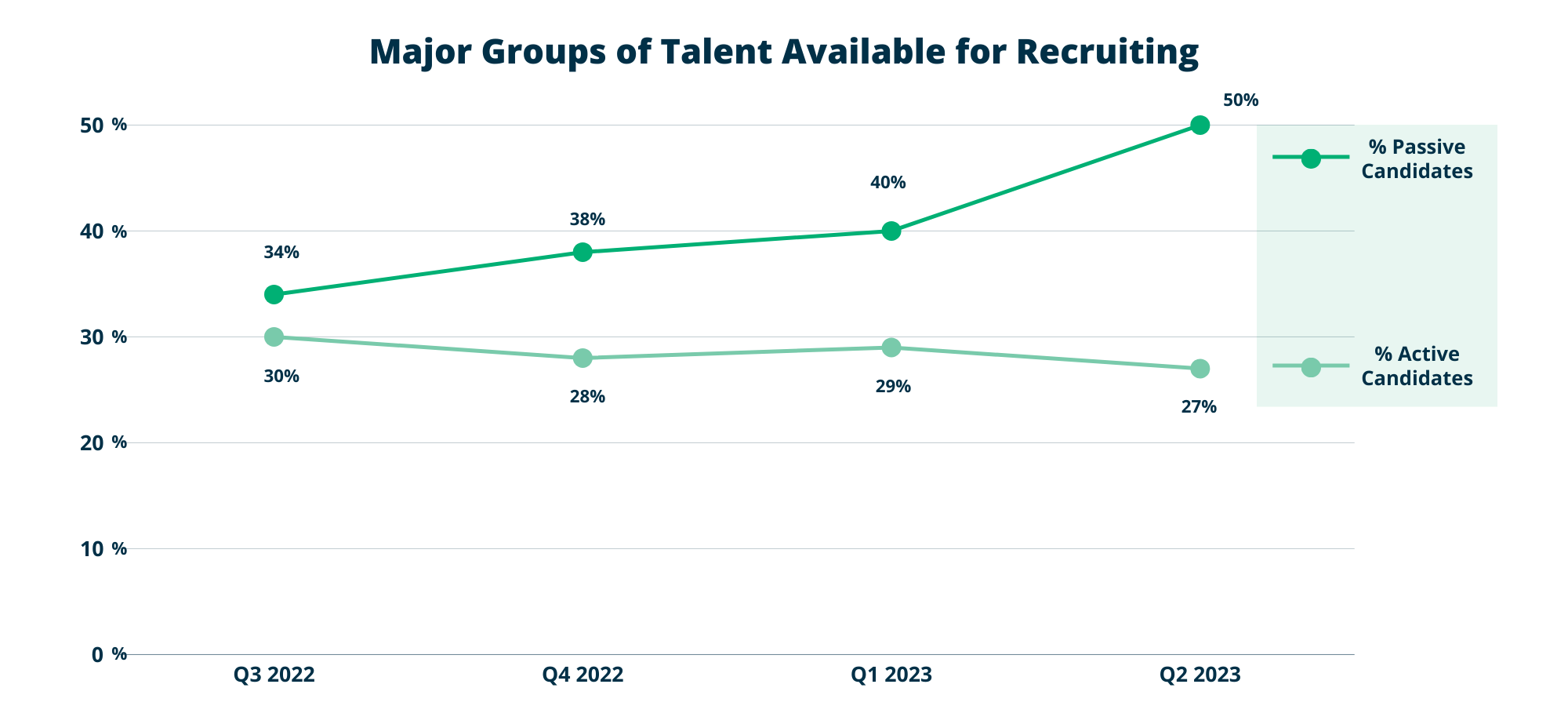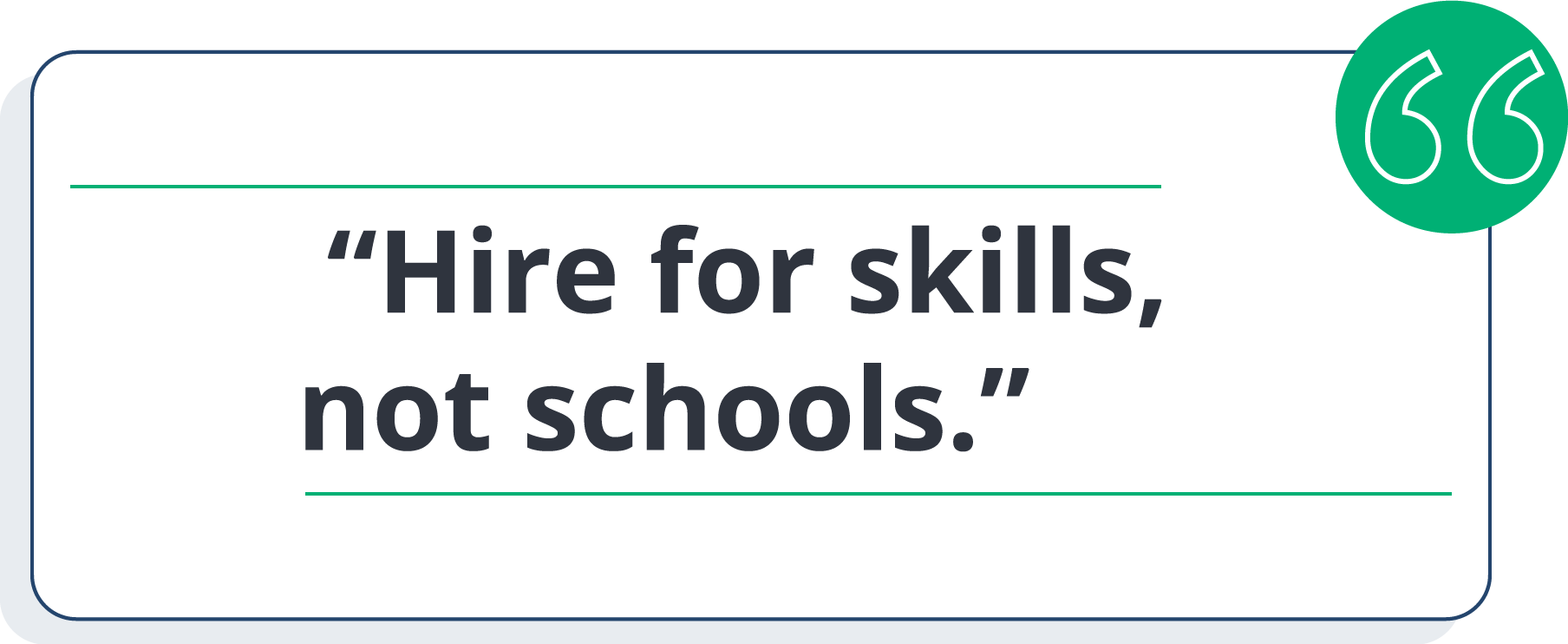There’s good news and bad news in the world of talent acquisition. The bad news is that the talent market won’t loosen up any time soon, which means you’ll have to fight even harder to source and hire top talent.
But the good news is that, if you’re aware of these four talent sourcing trends we see rising in 2024, you can use them to raise your talent sourcing game. The trick, however, is to run with the trends, instead of letting them run you down. Let’s get to it.
Trend 1: Unlocking Hearts and Minds – The Promise of Passive Candidates
With fierce competition for the cream of the active talent crop, attention is shifting to unlocking the potential of a huge pool of passive talent.
On your side is the rise of the fence-sitter, a passive candidate who hasn’t quite raised their “Yep, I’m interested” flag, but might easily do so if you spark their curiosity.
In the past year, while the number of active candidates remained relatively stable, the number of passive candidates grew to account for half of all available talent.

In the past year, while the number of active candidates remained relatively stable, the number of passive candidates grew to account for half of all available talent.
The secret to unlocking passive potential is to recalibrate your passive candidate engagement strategy with a bespoke approach, doubling down on engagement and super-personalization. It’s a hard ask.
After all, how can you ensure a personal, human touch with a zillion passive candidates when there are only three humans on your team?
For starters, try:
Strengthening your brand. Your brand is any candidate’s first stop. What message is it sending about you? Does it vibe with the candidates you’re trying to attract? What could you do to strengthen it? Use storytelling to paint a picture of your candidate’s potential future.
Understanding Gen Z motivations. As Johns Hopkins University’s Imagine Center points out, Gen Z (late 1990s to early 2010s) will make up 30% of the workforce by 2030, so understanding their motivations – especially if you’re not Gen Z yourself – is worth it. This is even more important, because competition for Gen Z will be strong, given that they won’t replace retiring Baby Boomers at the rate that’s needed.
A fair, purpose-driven workplace isn’t Gen Z’s only idea of a good time, but it’s a strong motivator. Social justice, transparency, and authenticity also matter. Do your engagement communications reflect this?
More Gen Z talent catnip includes a flexible workspace, engagement at work, and fast, mobile-driven communications. Make sure your job descriptions and communication methods align.
Trend 2: The Rise and Rise of AI
AI is a powerhouse of possibility for recruiters, and its development for and uses within the recruitment cycle continue to expand.
Although 62% of talent acquisition experts are optimistic about AI’s impact on recruitment, adoption levels are patchy. We found the statistics on implementation vary, according to sample size or who’s funding a given study. Thus while it seems like recruiters should be stampeding to adopt AI tools, the opposing reports below show this depends entirely on who you ask.
- In one recent survey, 42% of HR and talent acquisition leaders said they did not use or plan to use AI for talent sourcing.
- An alternative report suggests that while only 30% of respondents reported using AI, 81% planned to expand their use of AI in 2024.
What is certain is that adopters can take advantage of AI’s multi-faceted ROI, like efficiency gains, more accurate insight, resource planning, fairer recruitment, and enriched candidate engagement programs.
How you do this depends on your objectives or weak spots. Our clients, for instance, tell us that integrating Visage’s platform, which deploys AI candidate matching and crowdsourcing community with their applicant tracking system (ATS) empowers them to:
- Hire at higher volume.
- Create personalized communications for better engagement.
- Build more diversity into their passive talent funnel.

Trend 3: Sourcing Specialist Talent
Finding niche talent has gotten a little easier thanks to new tech, but remains hard to do. Whether you’re hiring for one particular niche role, or looking to improve the diversity of your entire passive talent funnel, those candidates remain elusive.
Replace the traditional “hope-for-the-best” recruitment methodology with a more nuanced, granular approach to sourcing specialist talent, which is characterized by:
- Skills-first hiring. This is sourcing with an emphasis on skills rather than job titles, schools, or traditional qualifications. This can help you reach candidates from alternative backgrounds with valuable skills that traditional recruiting methods might overlook.
- Building relationships with specialist organizations. The “build it and they will come” philosophy doesn’t work with hard-to-reach talent.Identify the organizations, online fora, or professional network groups that serve your target candidate, and go make friends. Be clear about what you can offer.
Trend 4: From Burnout to Standout – Enhancing the Recruiter’s Role
As AI applications continue to develop, recruiters will have more opportunities to shift from a reactive, administration-heavy role to one of proactive partnership and relationship building. The pivotal gains for recruiters are twofold: time and insight.
Time
AI can automate a ton of repetitive or manual tasks, reducing the administrative load in the talent acquisition cycle.
Eliminating busywork helps to combat recruiter burnout, but it also frees up precious time and headspace for recruiters to focus on core functions, like:
- Developing consultative and data analysis skills.
- Developing personal branding for deeper candidate engagement.
- Building productive relationships with hiring managers, diversity organizations, and specialist industries.
Insight
Recruiters can take advantage of AI’s many forms of data-driven insight to become a walking, talking knowledge base for continual improvement.
They can leverage opportunities to become the go-to experts on talent trends and the efficacy of recruitment strategies and can take a pivotal role in advising hiring managers.
Always Trending: The Human Touch
The Visage platform was built for recruiters. Every day they’re on the frontline, living their employers’ brand and creating massive positive impacts not just for their own organizations but on the lives and careers of the hundreds and thousands of candidates they nurture. We built Visage to empower them to do so, day in and day out.
It’s important to remember that human connection created by recruiters is the foundation of effective recruitment, and that AI can never replace this. If you’d like to see how Visage can help you search less, hire more, and stay human, reach out for a demo now.
CEO of Visage & Hopward, Joss is a 15-year veteran in the recruitment industry and a passionate thought leader in optimizing talent acquisition for companies big and small. Hailing from France, but at home on his ranch in Austin, TX, he enjoys free time with his wife and son and plays polo.

